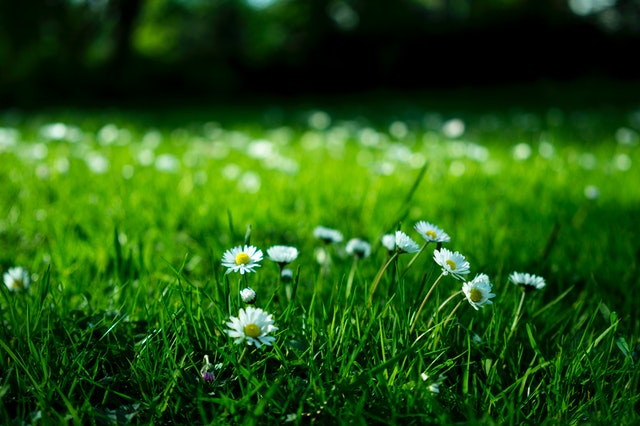
Greener Lawn Care
By Francesca Kelly for Go Green Highland Park
“High summer holds the earth.”
These words of poet James Agee are in my head as I look out on our small but exploding garden. This is the greenest time of year, the time for grazing (if you’re a cow) and lazing (if you’re a dog or human). When I was a child, I loved lying on the soft grass in the back yard, surrounded by blackberries and currants and that sweet summer “meadow” scent. I would look up to the tall trees that seemed to scrape the sky and watch the poplar leaves glitter in the sun as the breeze whooshed through them.
It was a good thing I was lying on the backyard grass, because lying on the front lawn would have elicited a good scolding from my dad. The back yard was for kids; the front yard was for show, and my dad was Mr. Lawn. He seeded, sodded, fertilized, mowed, tilled, aerated, trimmed, and limed that front yard, all to the end of “having the best lawn in town,” as he immodestly put it. But he didn’t use herbicides or pesticides, as he didn’t trust them. Instead, my brother and I were paid a penny for each weed we pulled by hand. (In the 1960s, this was good money, especially to a 9-year-old.)
My dad’s instincts were spot-on, as it turns out. Herbicides and pesticides can wreak havoc on the environment. And, if fertilizers are not used sparingly, and sprinklers are left on too long, run-off occurs — and those fertilizers end up in Lake Michigan, upsetting the chemical balance in our precious source of drinking water.
Caring for our gardens and lawns has become more than having the prettiest turf in town. We also are stewards of our soil, groundwater, streams and lakes. This stewardship means understanding how all of our actions have an effect on our planet.
Here are a dozen ways to care for lawns and gardens responsibly:
- Plant as many native species as possible, and consider replacing all or some of your grass with them. Native species are hardier and require less maintenance.
- Weed by hand or pay someone to do so. Put on some favorite music or listen to a podcast; or just live in the mindfulness of the moment. Eschew weedkillers such as RoundUp. RoundUp’s chemical compound, glyphosate, has been labeled a possible carcinogen, and its high acidity can affect the ecological balance of lakes and streams. You can learn about natural weed-killing methods here. Pressure-washing can temporarily eliminate weeds from patios and driveways.
- Wash and re-use plastic seed pots and other supplies instead of discarding or even recycling, which has become less reliable. Or donate them back to garden centers.
- Use fertilizers sparingly, and with precise targeting. A soil test will tell you what your lawn needs. Overuse of fertilizers can cause runoff into our streams and lakes and is a major source of nutrient pollution. You can also make your own fertilizer!
- Start a compost pile to help nourish your garden. Good compost is made up of about two thirds dry matter such as dried leaves and even shredded paper, and one third kitchen scraps such as fruits, vegetables, coffee grounds and eggshells. Keep stirring the compost regularly and consider having several piles (or compartments in a compost bins): one that’s “cooked” and one for newer scraps.
- Invest in a rain barrel to catch and use rainwater for watering, saving on your water bill.
- Water early in the morning or in the evening when it’s cooler and plants have time to absorb it.
- Create gardens and homes for wildlife. The National Wildlife Federation has a backyard certification program with guidelines on how to design a yard that attracts birds, butterflies, bees and other essential pollinators. Some flowers loved by pollinators include purple coneflower, trumpet vine, milkweed, bergamot, and many wild meadow flowers.
- Avoid rodenticides both inside and outside your home, especially second-generation anticoagulant rodenticides. These cause great harm to raptor populations. If you cannot remove mice humanely, mechanical traps are a better environmental choice than poisons (and far less cruel than glue traps).
- Plant a tree. Or two, or three! Trees filter carbon dioxide out of the environment and return oxygen. And they provide shade, as well as homes for many species of wildlife.
- Rethink that fence. Sure, you don’t want your dog to get out or a coyote to get in, but maybe leave a few small spaces for opossums and other critters to squeeze through. As demand for housing rises, wildlife habitats shrink. Opossums and skunks actually provide a service to gardeners by eating pests such as Japanese beetles, cutworms, slugs, snails, grubs and hornworms.
- Finally, if you hire landscapers or gardeners, request that they not use toxic chemicals and that they use electric lawnmowers and leafblowers — or a rake (remember those?). Go Green Highland Park is compiling a spreadsheet of landscaping/gardening services who do not use gas-powered leafblowers, and who adhere to other ecologically friendly methods such as hand weeding. Keep an eye on our website for a link to this list, coming soon.
Let’s enjoy our beautiful lawns, gardens and parks this summer; and take the steps necessary to preserve them for future generations.
If you enjoyed this article, please check here to see the rest of our Highland Park Neighbors articles.
